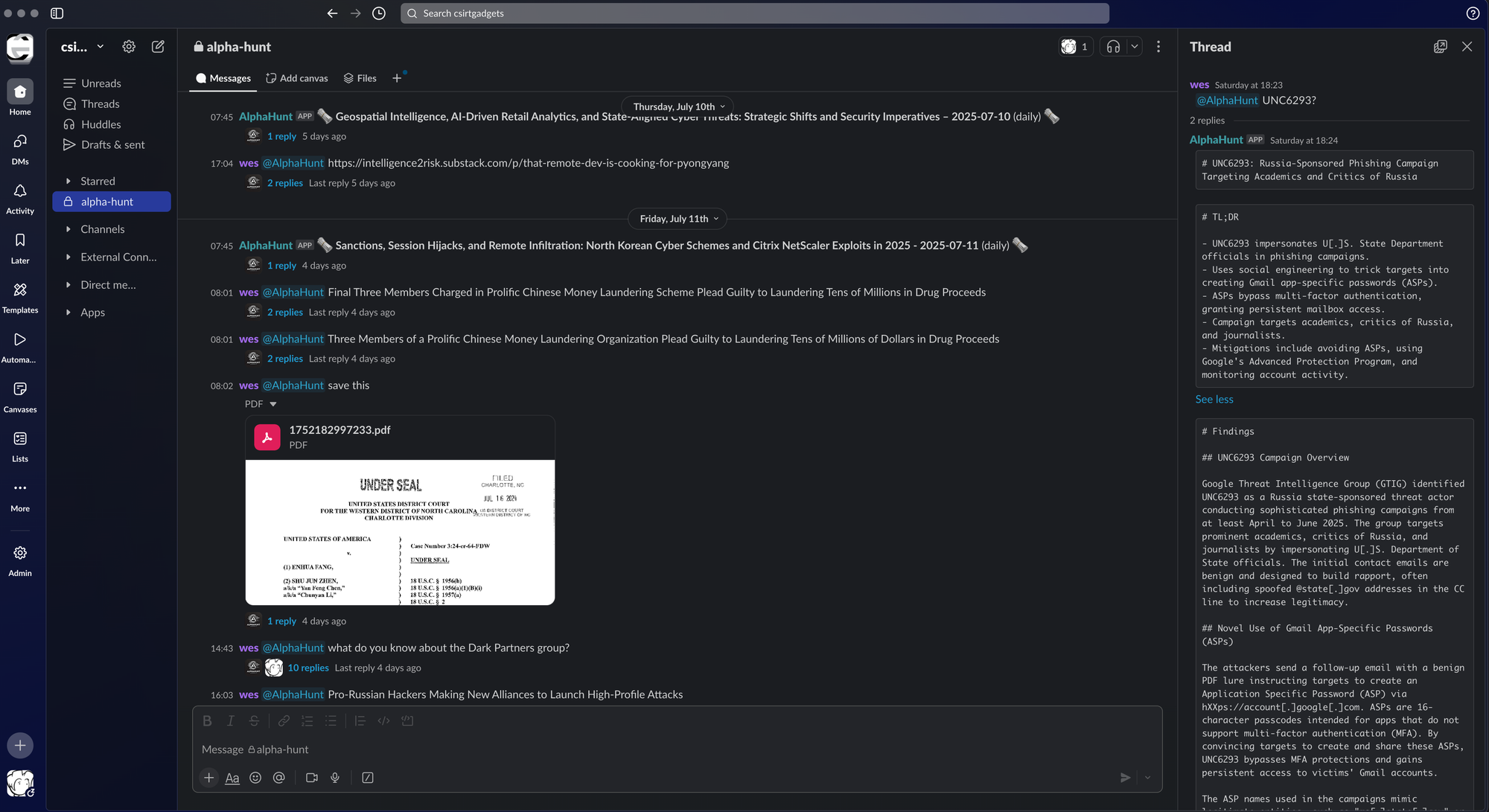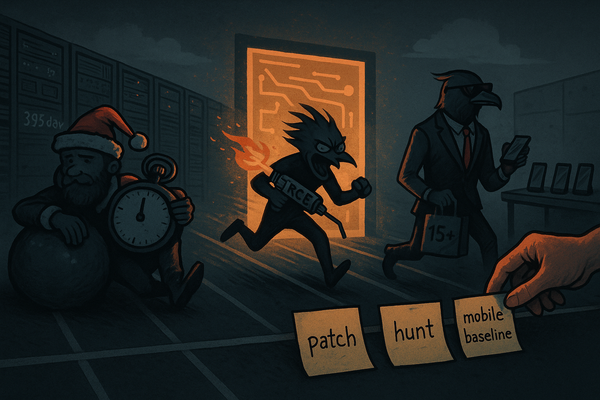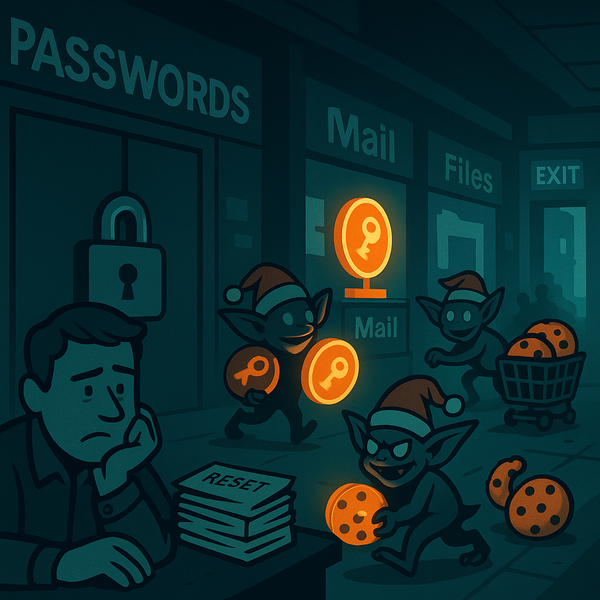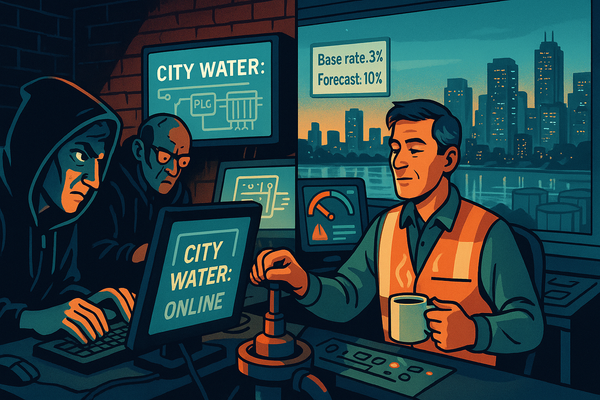Kill the Lights, Fire Up Starlink: Scam Compounds Slide South
Thailand pulled the plug. The grift brought generators + Starlink. Shift north→south (Shwe Kokko/Myawaddy; Tachileik/Mae Sai). Squeeze OTC cash-outs + first-funding friction, or watch it respawn.

TRIGGER WARNING
This problem space; romance scams, crypto and Myanmar casinos is not my sandbox. That’s the point. A research team I rate highly has been doing real work and calling out AI’s rough edges. I thought it was an interesting problem, have always admired their work and wanted to both test the edges of AlphaHunt and learn more. Here’s a high-altitude recon of the problem space..
Things I Learned..
- TTPs aren't always 'virtual', for example- if you're investigating where a 'compound' might be, think about visibility, utilities, political lines.. proximity to a gas station.
- 'Liquidity' might not always mean money-lender or bank, it could also mean casino.
- You know Starlink has become mainstream, when the criminals don't allow a disruption or two to impede their game.
- When you research things like this, your AI might ask you if you want geo coordinates too- just in case you have a 'spare drone' handy.
- The person on the other end of a scam, might also have a (literal) gun to their head.
- IntelligenceForGood does some great work, consider supporting them!
(I learned a lot in 20minutes- even if everything isn't 100% accurate, feel free to reply and highlight my mistakes..)
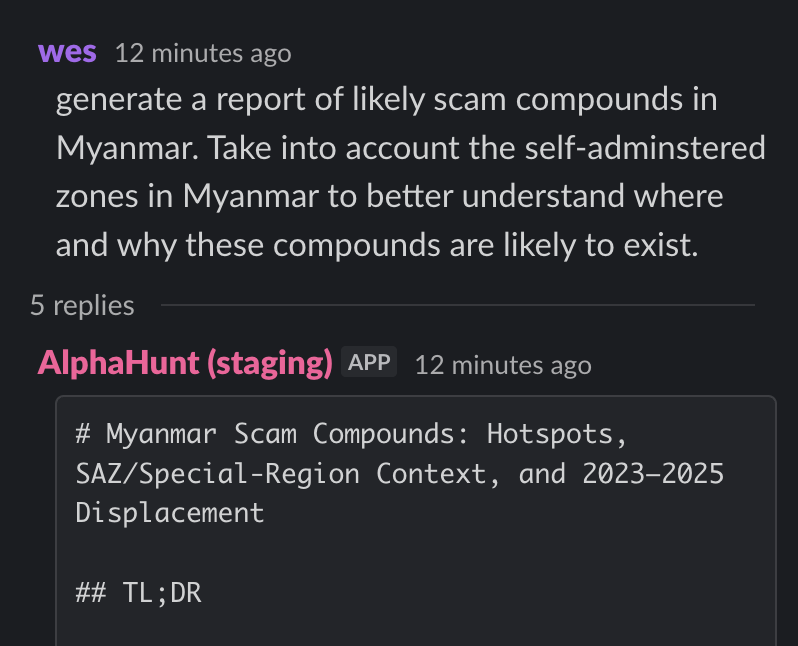
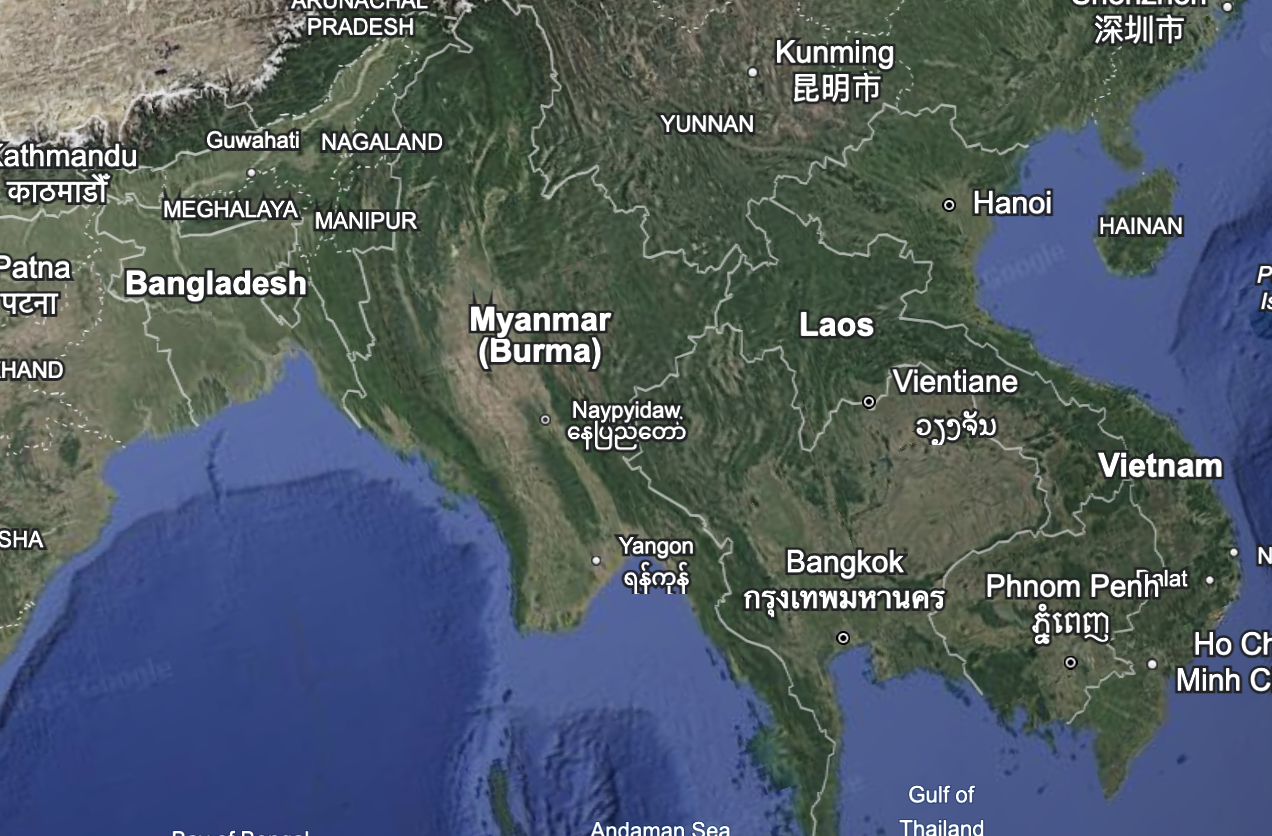
TL;DR
Key Points
-
Track displacement from Kokang to Shwe Kokko–Myawaddy, and Tachileik–Mae Sai.
-
Apply utility and connectivity pressure; expect higher costs, reduced uptime, and continued activity.
-
Choke cash‑outs via over‑the‑counter (OTC) brokers in Mae Sot/Mae Sai, and first‑funding friction controls.
-
Sanction landlords, concessionaires, and Border Guard Force–aligned security intermediaries.
-
action: Prioritize detections for romance/investment grooming, and rapid off‑platform pivots.
-
action: Implement first‑funding friction controls on wires to exchanges (holds, velocity caps, device fingerprinting).
The story in 60 seconds
Who/what/why: From 2023–2025, scams persisted in Myanmar’s self‑administered zones (Kokang, Wa Self‑Administered Division (Wa SAD), Special Region 4 (SR4)) and shifted south to the Karen borderlands (Shwe Kokko–Myawaddy, Tachileik–Mae Sai). Operation 1027 and China‑led repatriations of more than 53,000 suspects, plus Thailand’s February 2025 power cuts, disrupted northern hubs.
TTPs: Operators use spearphishing via service (T1566.003), malicious links (T1204.001), established personas/accounts (T1585), web protocols for communications with victims (T1071.001), rapid infrastructure acquisition (T1583), and brand lookalikes (T1036). Enclaves blend SIM/VoIP, cloned broker portals, crypto off‑ramps, generators, and satellite internet (e.g., Starlink).
Sector impact: Global users and enterprises face ongoing grooming, onboarding to fake brokers, and conversion via stablecoins and OTC brokers. Most leverage sits at utilities and connectivity, first‑cash‑out frictions, and sanctions against property and security facilitators.
AlphaHunt
Stop doomscrolling, start decisioning. We chewed through the muck so your team doesn’t have to. → Subscribe! • Forward to your on-call lead.
(Have feedback? Did something resonate with you? Did something annoy you? Just hit reply! :))
High Impact, Quick Wins
- Enforce first‑funding frictions with banks and exchanges: 24–48‑hour holds, device‑fingerprint velocity caps, and enhanced KYC for border‑district wires; measure bank/exchange hold rates, and declines in first‑time crypto wires.
- Block broker portals: DNS/URL filtering, and TLS inspection, where lawful/feasible, for finance‑themed newly observed domains; measure drops in session attempts, and clickthroughs.
- Detect grooming flows: Alerts on unsolicited outreach → encrypted migration → broker portal referrals; measure funds recovered, and intervention saves.
Why it matters
SOC
- Egress to finance‑themed newly observed domains with domain age <14–30 days, CDN‑fronted, and SNI/SAN lookalikes of broker brands.
- Unmanaged device IDs or atypical geographies accessing exchange APIs from corporate egress.
- Rapid installs and use of encrypted messengers, and VoIP outside the standard image.
IR
- Triage for scripts showing romance or investment grooming, PnL screenshots, and broker URLs.
- Preserve wallet addresses, device fingerprints, WalletConnect or QR‑wallet connect artifacts, and onboarding logs for SARs.
- Capture OTP/MFA prompts, clipboard‑helper usage, and sideloaded finance apps.
SecOps
- Enforce DNS/URL filtering, managed browsers, and extension allowlists; add finance‑portal categories.
- Require MFA and transaction alerts on any enterprise‑linked financial accounts.
- Block sideloaded finance apps; monitor installer hashes for OTP and clipboard utilities.
Strategic
- Coordinate with banks and exchanges on first‑funding holds, and mule‑cluster takedowns.
- Advance sanctions against Shwe Kokko landlords, concessionaires, and Border Guard Force–aligned security intermediaries.
- Maintain Thai utility cuts, and engage satellite providers on geofenced terminal disablement.
See it in your telemetry
Network
- Sudden traffic to newly observed finance domains (registered <30 days), or spikes >5× baseline within 24 hours per egress point.
- TLS SNI/SAN near‑misses to known broker brands, and shared JA3/JA4 with scam‑portal clusters, where lawful/feasible.
- First‑time exchange API access from unmanaged device IDs, and connections to Tron RPC endpoints or exchange deposit APIs from corporate egress.
Endpoint
- New installs of encrypted messengers or VoIP outside the standard image; process lineage from browsers or messaging apps.
- Appearance of clipboard/OTP helpers, QR‑code scanners, or screen‑capture tools preceding exchange onboarding.
- Browser artifacts: wallet‑connect attempts, autofill to new finance domains, and downloads of broker “apps” not from official stores.
AlphaHunt Converge - Plug in your Flight Crew
Get intelligence where it counts. No dashboards. No detours. AlphaHunt Converge teases out your intent, reviews the results and delivers actionable intel right inside Slack. We turn noise into signal and analysts into force multipliers.
Anticipate, Don’t Chase.
DEEP RESEARCH: Myanmar Scam Compounds: SAZ Hotspots, Cross‑Border Spillovers, and 2023–2025 Displacement Patterns
TL;DR
- Scam hubs persist in Myanmar’s SAZs/Special Regions: Kokang (Laukkai), Wa SAD (Pangkham/Panghsang), Special Region 4/Mong La, and Karen borderlands (Shwe Kokko–Myawaddy).
- Operation 1027 and China-led pressure disrupted northern hubs; networks relocated south toward Thai border nodes, not dismantled.
- Thailand’s February 2025 power cuts targeted Myawaddy/Tachileik/Payathonzu; compounds pivoted to generators/Starlink, showing resilience.
- Public reporting confirms tens of thousands repatriated from northern hubs; many operations reconstituted along the Karen corridor.
- Policy leverage is highest at utilities, financial off‑ramps, border OTC brokers/mules, and sanctions on landlords/security intermediaries.
Scope and Audience
- Purpose: Policy/leadership/awareness brief on likely scam-compound locations in Myanmar, with emphasis on self-administered zones (SAZs)/Special Regions and adjacent Thai nodes.
- Timeframe: 2023–2025 with verifiable open-source reporting.
- Method: Synthesize first-party/multilateral and major media investigations; avoid speculative facility‑level claims; focus on zones, enablers, and disruption levers.
Executive Context: Why SAZs and Borders Host Scam Compounds
- Governance gaps and armed intermediaries:
- Territorial fragmentation and de facto authorities (e.g., MNDAA in Kokang, UWSA in Wa SAD, NDAA in SR4, Karen BGF-aligned elements near Myawaddy/Shwe Kokko) enable compound concessions, security, and rent-seeking.
- Utilities/connectivity and cross-border access:
- Thai-side electricity/internet long fed Karen corridor compounds; cuts in Feb 2025 prompted pivots to generators and satellite links (e.g., Starlink), sustaining operations.
- Displacement logic:
- “Crackdown → adaptation → relocation” across Mekong borderlands. Northern hubs disrupted post-Operation 1027 saw workforce/management displacement toward Karen frontier, not cessation.
- Convergence with other illicit economies:
- UNODC notes growing overlap among underground banking, illegal gambling, drug proceeds, and cyber-enabled fraud tied to cross-border hubs.
2023–2025 Timeline: Disruption North, Consolidation South
- 2023–2024 (Northern Shan/Kokang: Laukkai/Laukkaing):
- 3BA/Operation 1027 offensives disrupted entrenched telecom-fraud infrastructures; Chinese pressure and repatriations of tens of thousands of Chinese suspects followed.
- Chinese authorities/public reporting cite over 53,000 Chinese suspects repatriated from northern Myanmar; northern “large compounds” described as “eradicated,” with relocations southward to Myawaddy.
- 2024–2025 (Karen corridor: Myawaddy/Shwe Kokko and satellite nodes):
- High-profile rescues and international scrutiny (e.g., Chinese actor case) elevated risk; Thailand implemented border utility cuts in Feb 2025 targeting Myawaddy, Tachileik, Payathonzu.
- Compounds in Shwe Kokko demonstrated continuity using generators; reporting ties facility protection and land concessions to the Border Guard Force (BGF)-aligned structures.
- 2025 (Policy tightening and visibility spikes):
- Thai authorities signal multi-month utility-cut timelines; reputational/tourism pressure from China accelerated measures.
- Investigations show Shwe Kokko attempts at “image management,” while smaller, rougher compounds persist southward along the border.
"Most Likely” Zones
- Northern Shan (SAZ/Special Regions):
- Kokang (Laukkai/Laukkaing):
- Status: Disrupted by 2023–2024 operations; mass repatriations to China; residual networks displaced to other enclaves.
- Why likely historically: Proximity to China; entrenched triad-linked operations; permissive local governance pre-Operation 1027.
- 2025 outlook: Large hubs decreased; watch for reconstitution in smaller facilities or adjacent Special Regions.
- Wa Self-Administered Division (Pangkham/Panghsang):
- Status: Historically permissive enclave economies; documented overlap with illicit markets; ongoing risk of hosting services supporting fraud/gambling operations.
- Why likely: Longstanding autonomous control, cross-border logistics, and legacy infrastructure conducive to cyber-enabled operations.
- Special Region 4 (Mong La/NDAA):
- Status: Enduring illicit-services economy; periodic reporting on online fraud and gambling ecosystems.
- Why likely: Legacy of casino-driven economies and cross-border commerce; bandwidth and real estate availability.
- Kokang (Laukkai/Laukkaing):
- Karen borderlands (Thai frontier):
- Shwe Kokko–Myawaddy (Kayin/Karen State):
- Status: Persistent core hub. Shwe Kokko’s high-rises/“new city” remain closely associated with online scams/illegal gambling and human trafficking; power cuts in Feb 2025 blunted but did not halt activity (generators, satellite connectivity).
- Why likely: De facto protection by BGF-aligned structures; access to Thai utilities/logistics; rapid reconstitution capacity.
- South of Myawaddy/KK Park/Dongmei and smaller enclaves:
- Status: Multiple smaller compounds described as more clandestine/rough facilities; active victim flows and continuing fraud operations along riverine crossings.
- Why likely: Displacement from marquee hubs; easier to hide in fragmented security environment; flexible infrastructure.
- Tachileik–Mae Sai corridor (eastern Shan):
- Status: Thai authorities targeted power connections in Feb 2025; mixed reliance on Lao-sourced electricity; continuing risk given long-established OTC/mobility routes.
- Why likely: Cross-border urban pairing supports logistics, recruitment, and financial cash-out.
- Shwe Kokko–Myawaddy (Kayin/Karen State):
Comparative Table: Hotspots, Enablers, Enforcement Signals, Risk
| Zone (Myanmar) | Likely towns/nodes | Enablers | 2023–2025 enforcement signals | 2025 risk posture |
|---|---|---|---|---|
| Kokang (Laukkai/Laukkaing) | Laukkai | China-proximate, legacy telecom-fraud infra | Operation 1027 disruptions; >53k Chinese suspects repatriated; “eradicated” claims for large hubs | Medium (displaced/fragmented, watch adjacent enclaves) |
| Wa SAD | Pangkham/Panghsang | Autonomous governance, illicit-services legacy | Ongoing illicit-economy reporting; less publicized crackdowns | Medium (latent hosting risk) |
| Special Region 4 (Mong La) | Mong La | Casinos/online gambling, cross-border trade | Continued illicit-services reporting | Medium (persistent illicit-service economy) |
| Karen corridor | Shwe Kokko–Myawaddy; KK Park; southward enclaves | BGF-linked protection; Thai utilities/logistics; rapid reconstitution | Thai power cuts (Feb 2025); visible resilience (generators, Starlink); high-profile rescues | High (active core) |
| Eastern Shan border | Tachileik–Mae Sai | Thai/Lao utility access; trading/logistics nexus | Thai power cuts; contingency Lao power reported | Medium-High (adaptive utilities/OTC networks) |
Note: Enclave labels and facilitators reflect reporting; do not equate all actors with monolithic “groups.” Affiliations, protection arrangements, and tenants are fluid.
Operating Model in Compounds: Victim Funnel and Monetization
- Lure and grooming:
- Social/messaging seeding by scripted personas (romance/investment “pig-butchering,” crypto plays).
- Migration to encrypted chat; staged “broker” portals with fake PnL; reputation-building across platforms.
- Workforce sourcing:
- Mix of voluntary and trafficked workers; forced criminality documented; debt bondage, violence, and quotas.
- Infrastructure:
- Compounds blend call-centers, SIM/VoIP orchestration, cloud-hosted portals, identity and OTP bypass services.
- Utilities resilience via generators and satellite (e.g., Starlink) after Thai cuts; controlled perimeters with militia security.
- Cashing and laundering:
- Crypto wallets to OTC brokers across Mae Sot/Mae Sai; layering across e-wallets, mules, nominee shops; casino/real-estate sinks.
- Convergence with illegal online gambling and drug proceeds noted by UNODC.
Awareness and Public-Safety Campaign Themes (Leadership-Ready)
- High-risk lures and “tells”:
- Sudden “friend” outreach on social apps; migration to encrypted messaging; unsolicited “mentorship” in crypto/forex; screenshots of impossible returns; urgency to move funds off-platform.
- Protective behaviors to message widely:
- “Pause before pivot”: refuse moving conversations off original app; verify identities through video/third-party channels; never fund wallets from a broker you didn’t solicit.
- “First funding = first friction”: banks/fintechs to warn users on first outbound wires to exchanges/OTC; reinforce 24-hour cooling-off and real-time scam-intervention lines.
- Travel/job-seeker advisories:
- Red-flag foreign job offers with upfront travel; no-questions-asked visas; hostage-conditions (passport seizure) and “quota” sales roles; avoidance of border towns.
- Encourage family “trip plans” and location sharing; embassy hotlines for suspected trafficking.
Policy Levers: What Works Against SAZ-Based and Border Compounds
- Utilities and connectivity pressure (short-cycle):
- Maintain Thai border utility suspensions with measurable KPIs; coordinate with Lao PDR to limit backfill to targeted enclaves.
- Engage satellite providers for usage policy enforcement, device seizure collaboration (Myanmar reports of Starlink seizures), and telemetry support.
- Financial choke points (short-to-mid-cycle):
- Risk-rate Mae Sot/Mae Sai/Tachileik OTC brokers and remitters; enforce beneficial ownership/KYC and device-fingerprint velocity controls at “first cash-out.”
- Public–private operations to freeze mule clusters; early-warning on high-risk funnel behaviors (cross-platform grooming, crypto off-ramps).
- Landlord/security facilitator sanctions (mid-cycle):
- Package evidence for sanctions against property developers, concessionaires, and security intermediaries providing protection, utilities, or logistics to compounds around Shwe Kokko/Myawaddy.
- Coordinate with partners (US/EU/UK) for synchronized designations to raise operating costs.
- Cross-border law enforcement frameworks (mid-cycle):
- Press for multilateral tasking (ASEAN/ACMECS) including China, with shared norms for data handling and joint investigations; reduce exclusive bilateral control over intelligence disposition.
- Border intelligence nodes (Mae Sot/Mae Sai) uniting cyber, customs, immigration, AML, and financial-intelligence workflows for continuous targeting.
- Victim-centered extrication:
- Scalable pathways for safe handovers, medical/legal support, and repatriation; shield victims from criminalization for forced criminality.
Measures of Effectiveness (Leadership Dashboard)
- Infrastructure stress:
- Number/duration of utility disconnections; satellite-device seizures; ISP/hosting takedowns linked to border compounds.
- Financial interdiction:
- OTC broker enforcement actions; crypto off-ramp freezes; mule-network arrests and account closures in border districts.
- Victim protection:
- Volume/time-to-extrication; multi-national victim repatriations; hotline engagement; survivor services delivered.
- Attack surface reduction:
- Decline in first-time outbound wires to high-risk destinations; reduced cross-platform grooming telemetry from top social/messaging apps.
- Displacement detection:
- Emergence of new enclaves post-enforcement (watchlists for Payathonzu-adjacent zones; southern Karen river crossings; Lao-proximate nodes); rapid re-targeting if relocation detected.
Risk Outlook and Planning Assumptions (2025–2026)
- Persistence over pause:
- Even with sustained utility cuts and reputational pressure, enclaves adapt with generators/satellite links; expect reductions in throughput, not elimination.
- Southward diffusion:
- Continued migration from marquee compounds into smaller, distributed sites along Thai borderlands and into Lao-adjacent corridors; harder to count, easier to hide.
- Financial innovation:
- Deeper use of stablecoins/mixers, identity farms, and e-wallet layering; shift to OTC brokers and nominee businesses near border towns.
- Strategic implication:
- Success hinges on synchronized pressure across utilities, finance, and local facilitators—plus credible, victim-centered extrication—to raise costs systemically and deny easy reconstitution.


